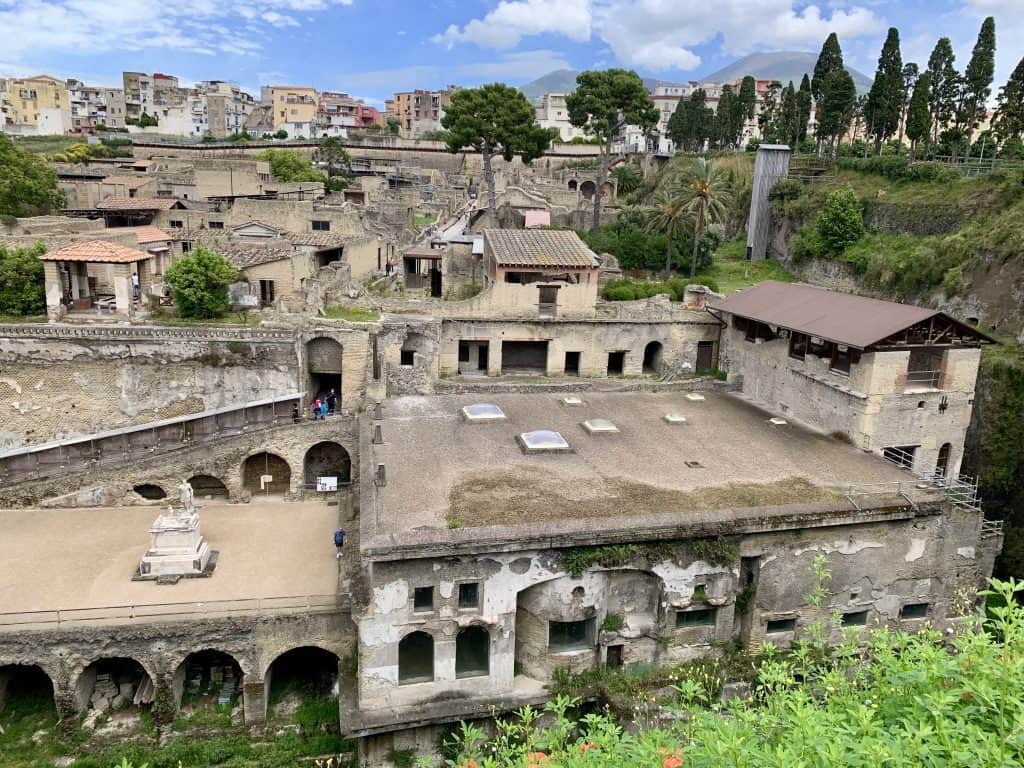
When Mount Vesuvius erupted in 79 AD, the lava, heat, ash and smoke destroyed a city, killing its residents and burying the city under 20 m of ash. That description brings to mind Pompeii, the extremely famous site that was a must-stop for well-heeled 17th and 18th century upper-class travellers. That, however, is not the city I’m referring to. I’m talking today about the other town wiped out by Mount Vesuvius in 79 AD, Herculaneum.
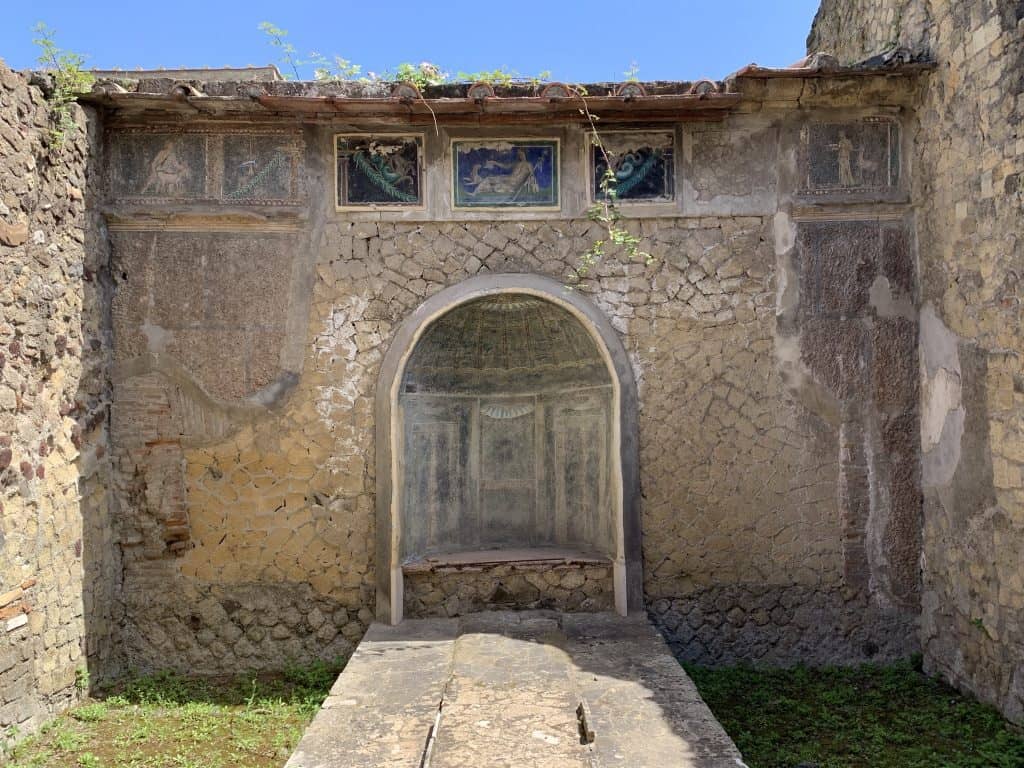
Herculaneum is the less-visited of the two destroyed cities. I’m here to tell you that it’s a spot to put on your Campania to-do list. Not as a substitute for Pompeii – Pompeii is one of the most popular tourist attractions in Italy for a reason – but in addition to Pompeii. While Pompeii gives you a unique snapshot of Roman life, Herculaneum is better preserved and shows you exactly how a wealthy Roman town was laid out and constructed. It’s a more compact site which is easy to see in a few hours. It’s also a UNESCO World Heritage Site. You will have a lot more space and time for yourself than on a visit to Pompeii. Herculaneum does not get the crowds that Pompeii does so for the most part you can wander around without lining up to get a split second look at frescos or sites before you have to move on.
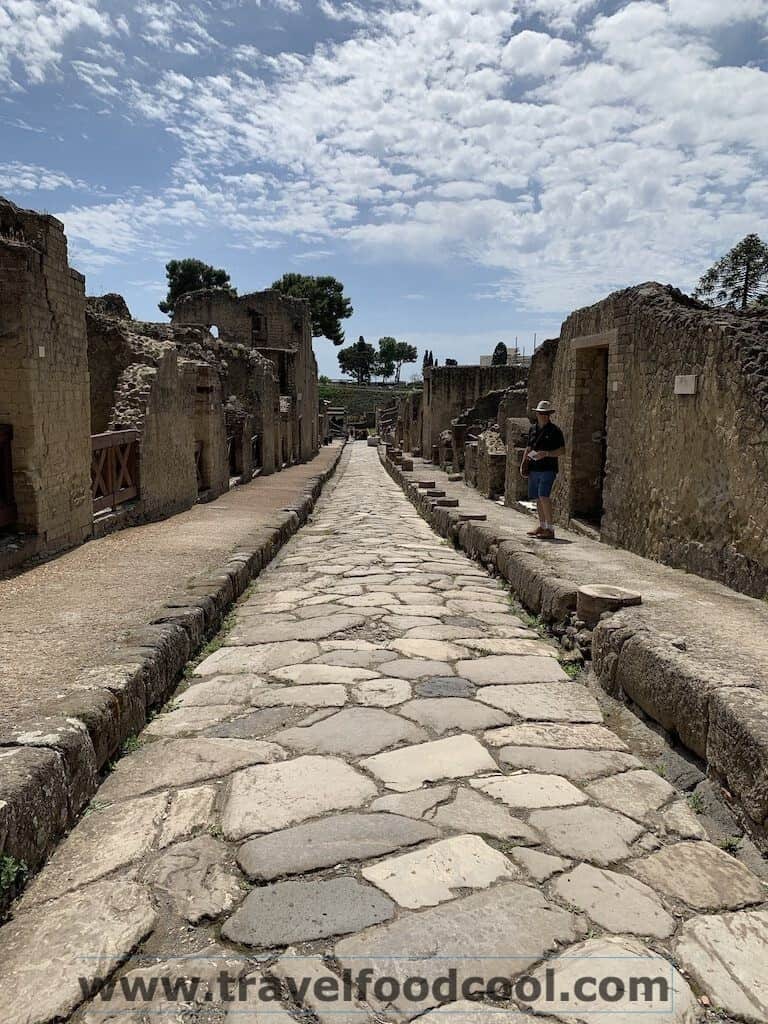
A little background history:
Herculaneum was named after the Greek god Hercules, who was said to have founded the town in 1243 BC. Prior to the eruption in 79 AD, it was a city of 4,000 – 5,000 people. Due to its mild climate, coastal location and clean air, it became a vacation spot for wealthy Romans.
Vesuvius’ eruption in 79 AD destroyed Herculaneum in a different way than it did Pompeii. The high winds on day one of the eruption caused more damage to Pompeii. In the city of Pompeii, home to 15,000 – 20,000 inhabitants, roofs of buildings collapsed under the weight of the ash and the city was buried under 4 m of volcanic ash.
In Herculaneum, while the eruption’s toxic gas cloud wiped out the inhabitants, the flow of ash and volcanic rock sealed the entire city. This city was buried under 20 m of volcanic ash, but it also managed to preserve organic materials like food, clothing, vegetation and wooden structures. Vesuvius’ lava and ash flow didn’t destroy the buildings – in some cases, two-story buildings were covered intact.
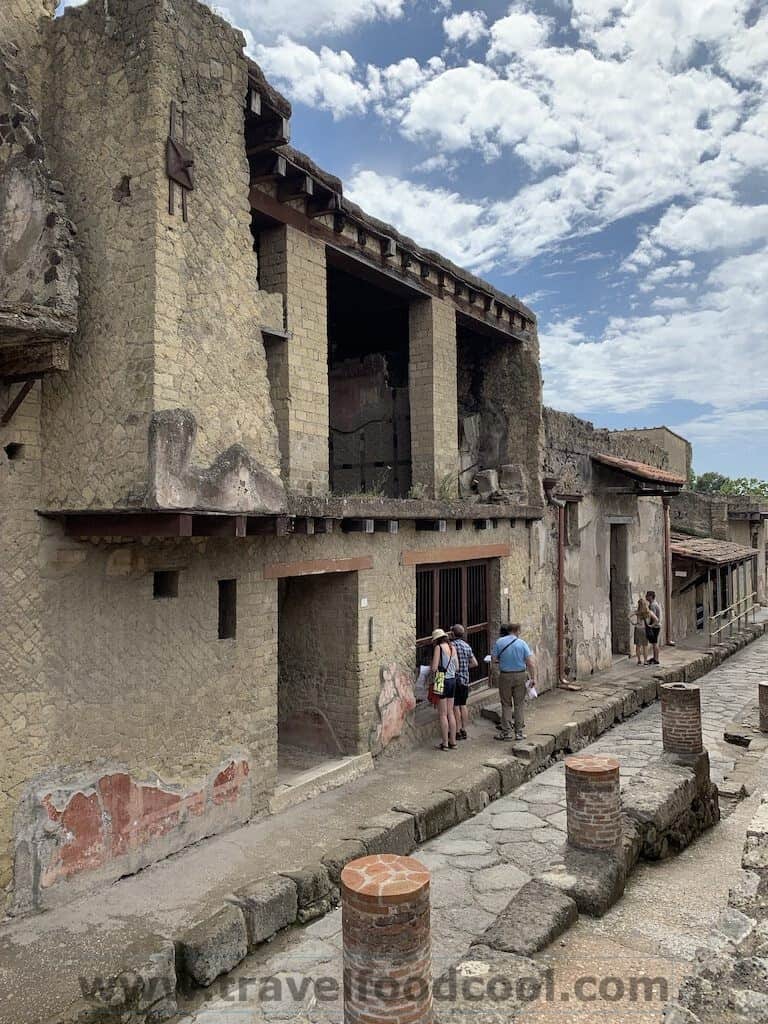
It took longer to discover Herculaneum than it did Pompeii, in fact, the location was discovered by accident. If the Prince of Lorraine, Emmanuel Maurice, hadn’t wanted a well, who knows when the city would have been found. While digging this well, workers came across marble fragments and statues that had once graced Herculaneum’s ancient theatre. This became a poorly kept secret and soon thieves constructed a series of tunnels to loot some of the town’s riches.
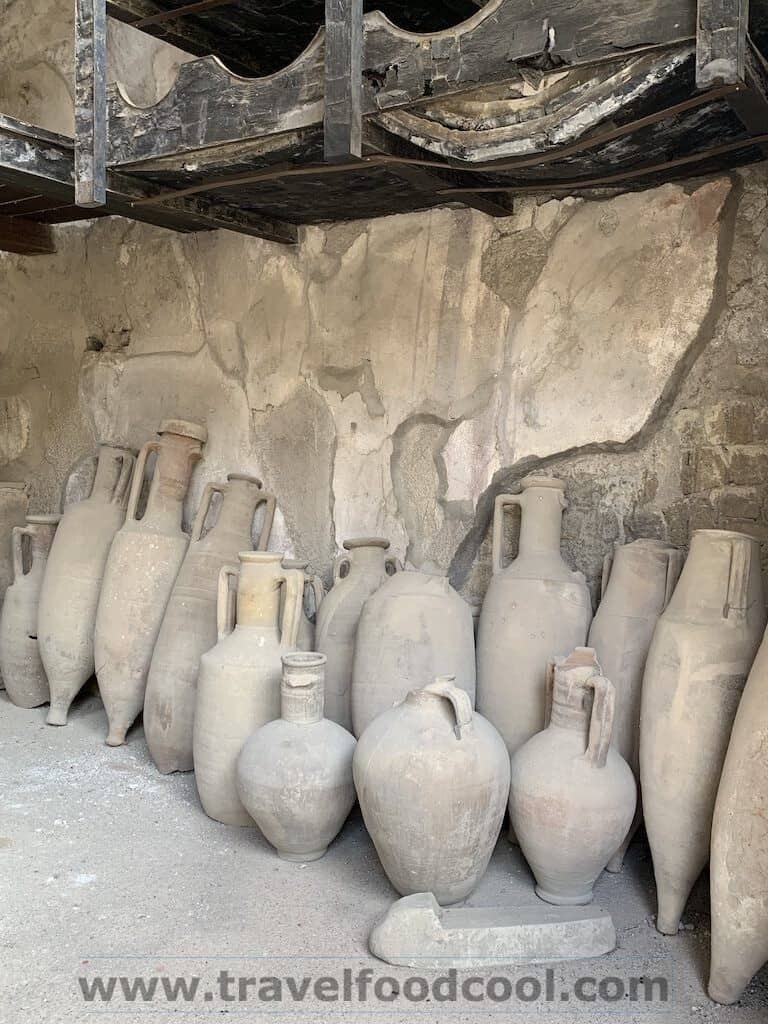
The Accademia Ercolanese (Ercolano was the town that had sprung up atop and near the site) was established in 1755 after a series of important discoveries, however, after 1792, excavations were suspended until 1927. How did this benefit the restoration of Herculaneum?
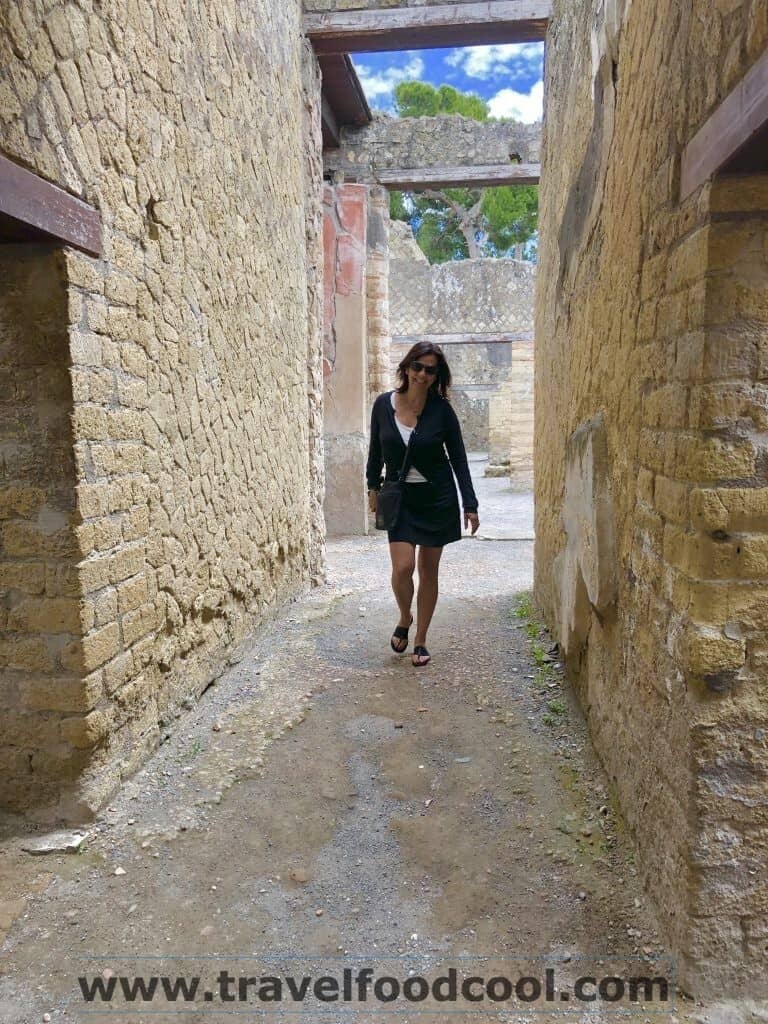
Now, I know what you are thinking, “Hey, wasn’t Pompeii excavated in 1748 when it was discovered by a surveying engineer?” Yes! you are right, but only partially right. The first attempts at Pompeii excavations were during the reign of Emperor Alessandro Severo (222 AD- 235 AD). It was between 1594 -1600 that they started to find things like coins and suggestions of buildings.
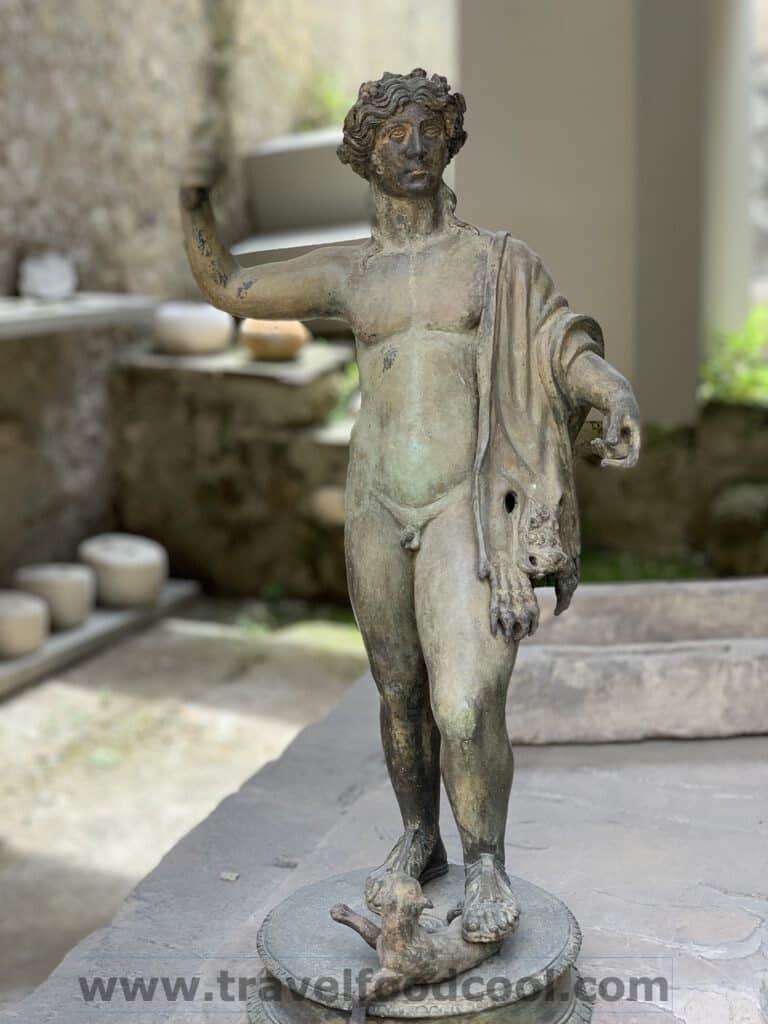
With Herculaneum, there was a delay in excavation from 1792 – 1927. When excavation started again, it was done in a more systematic manner and made use of more modern excavation techniques. It is considered to be better preserved than Pompeii.
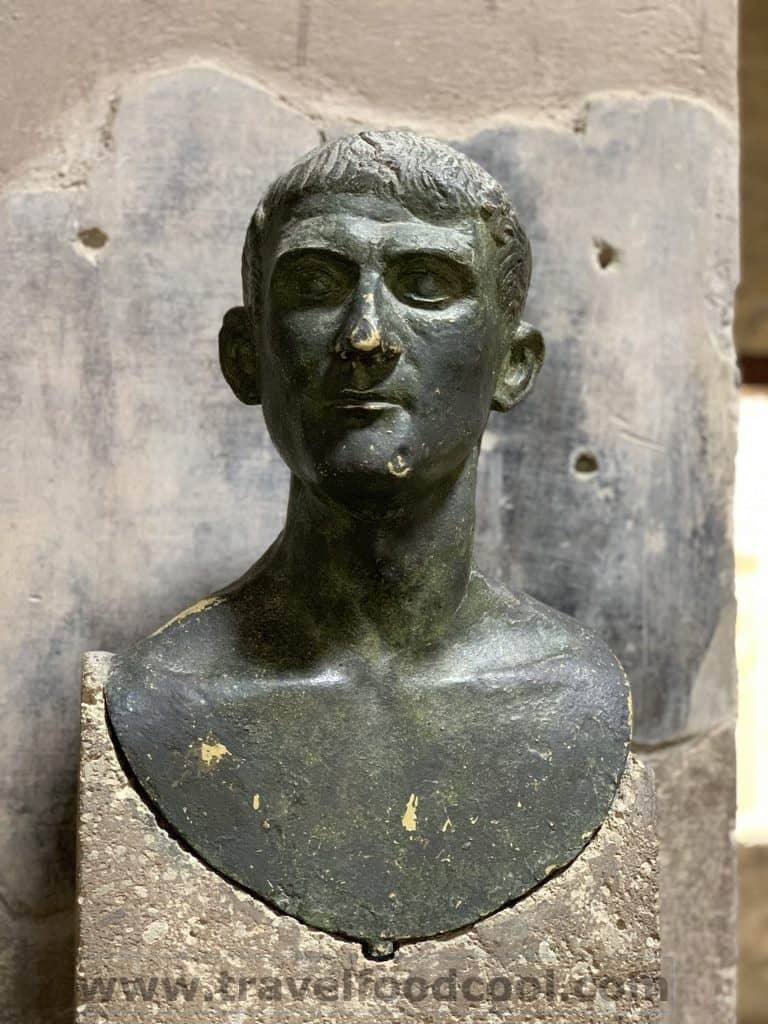
In fact, it was in the 1980s that some major finds like the baths, the Temple of Venus and the ancient Greek port (more about that in a bit) were uncovered. Since 2000, the Villa of the Papyrus and the library have also been uncovered.
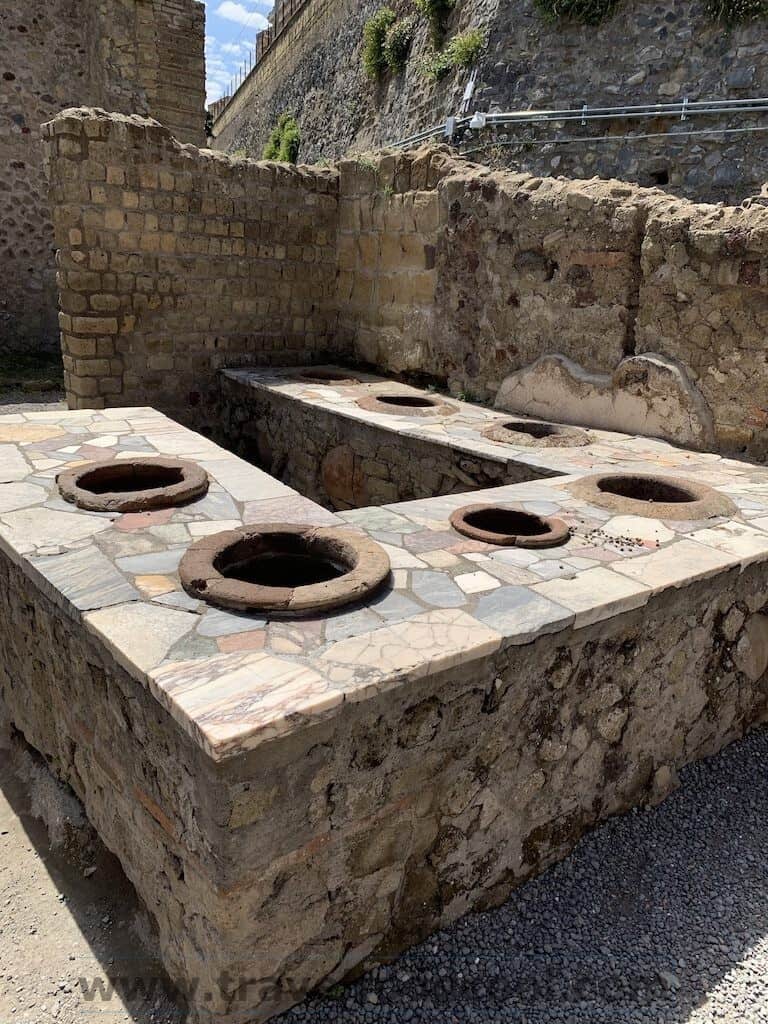
One other difference between Pompeii and Herculaneum is the mistaken belief that Herculaneum’s citizens managed to flee the volcano’s wrath – this was believed to be true as there were no bodies found. Sadly, in the 1980s, the Greek port warehouses were uncovered and with it about 300+ bodies.
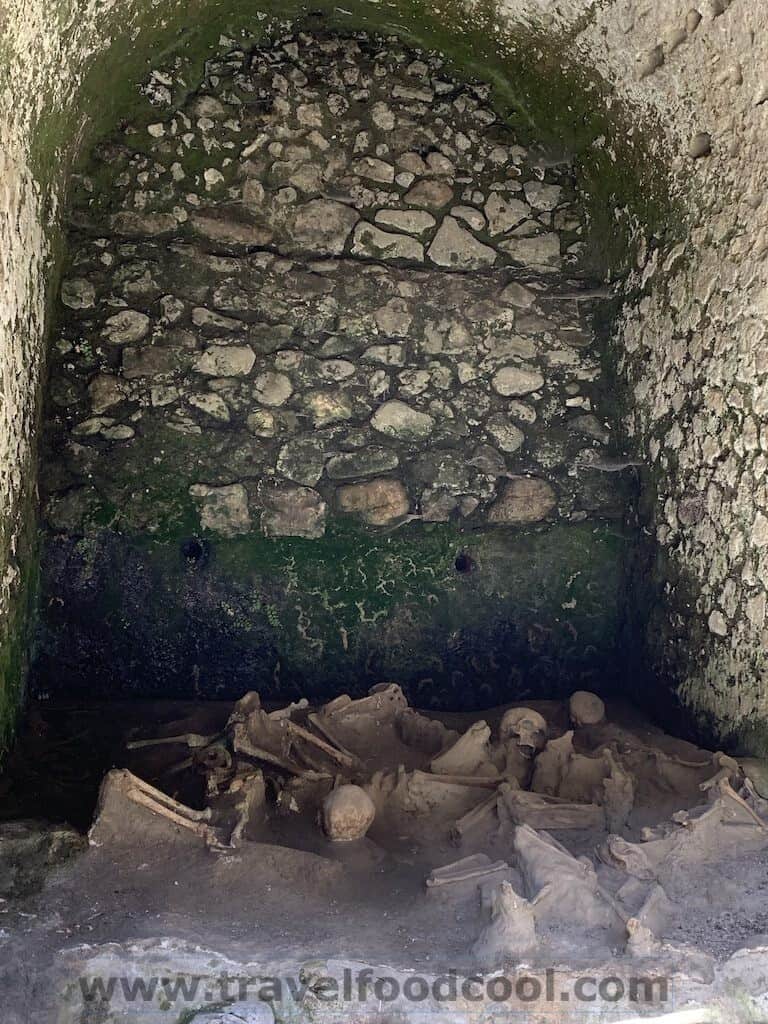
While there are lots of sites to see in Herculaneum, I’m going to highlight only a few.
House of the Mosaic Atrium
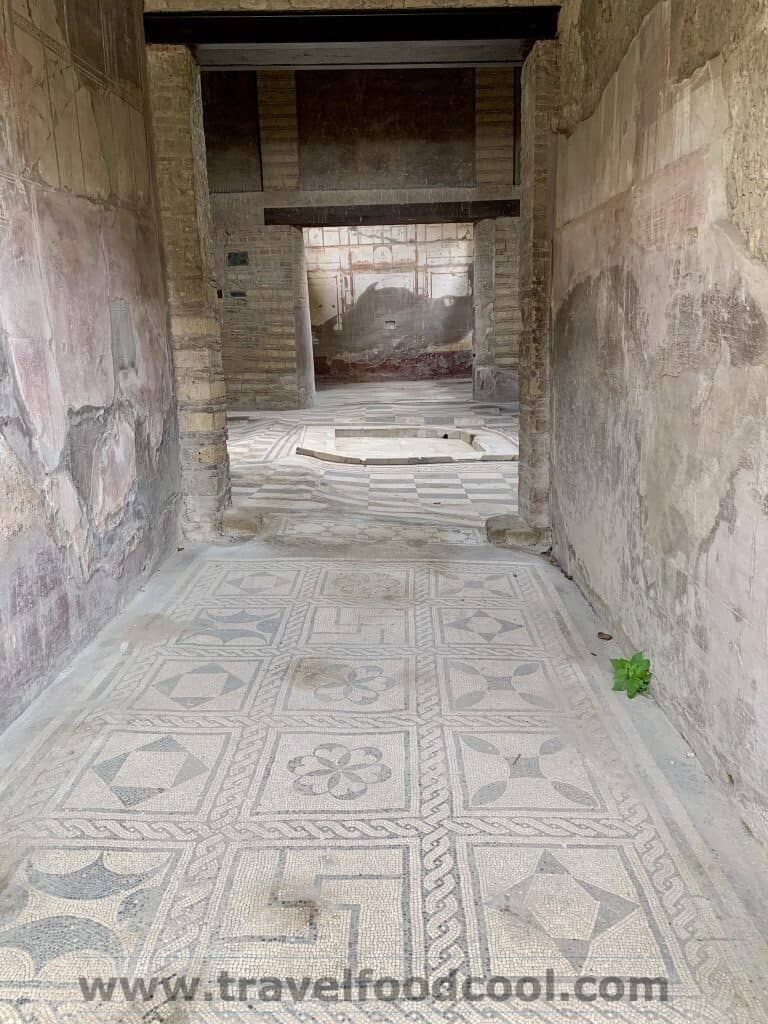
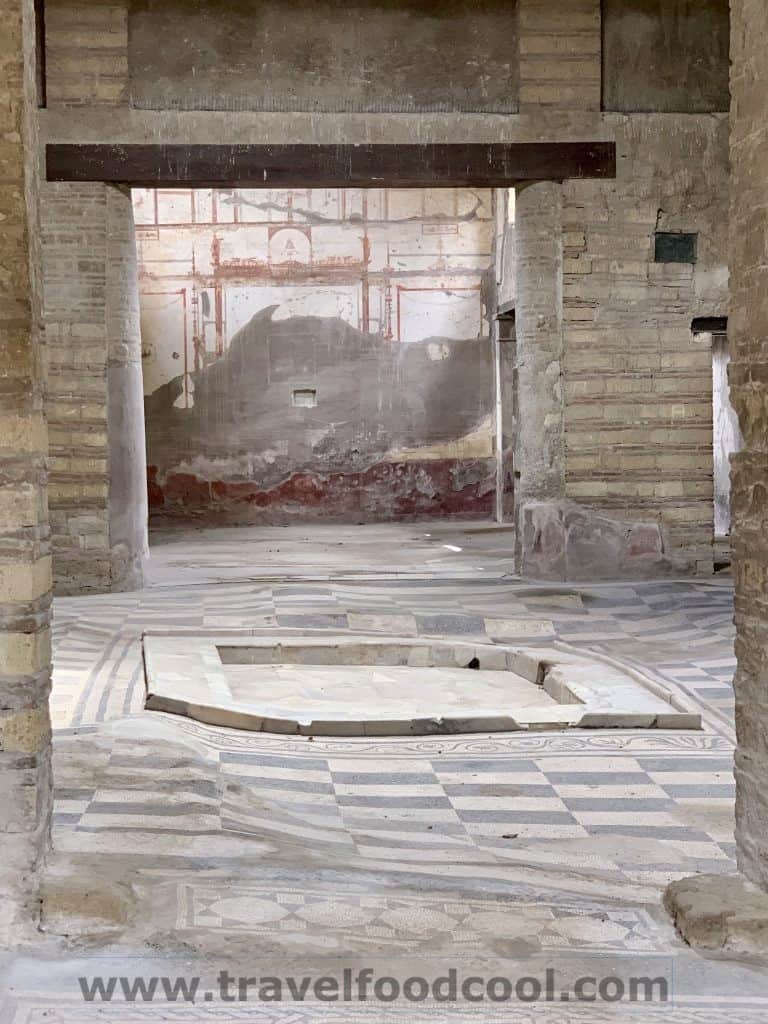
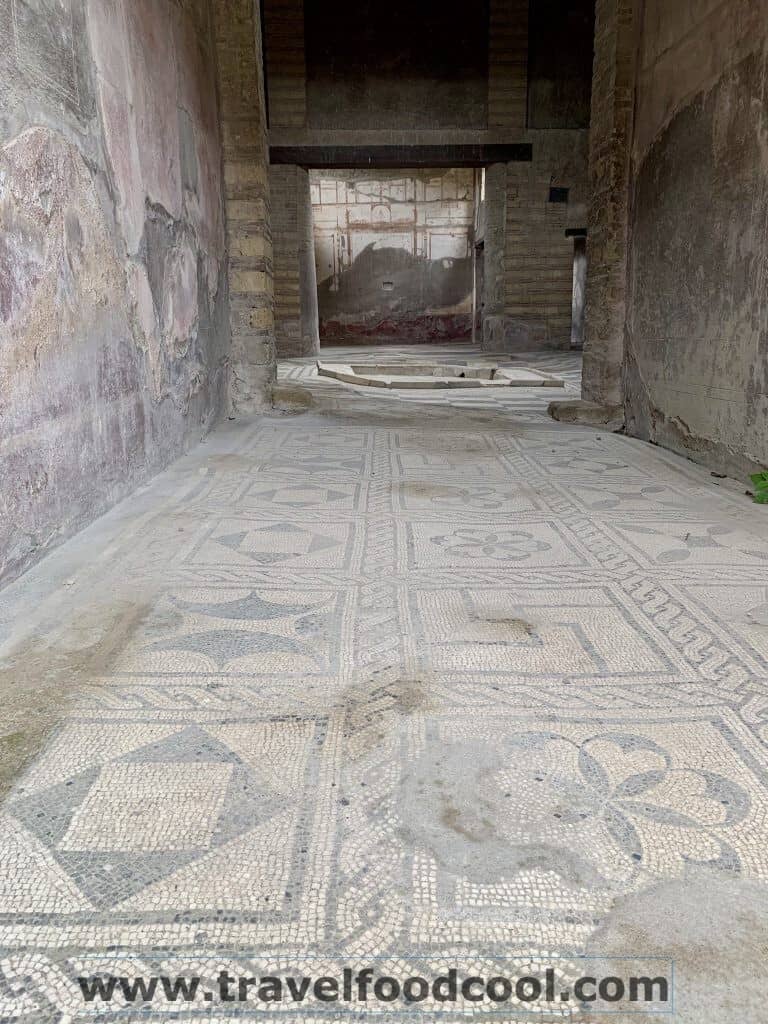
This house covers an area of over 1200 sq. m. and is quite close to the House of the Deer (see below). Like its neighbour, there are decorated rooms, large gardens and a great sea view. This house (as its name suggests) has spectacular black and white geometric mosaics covering the floor. The floor has buckled and is uneven and wavy due to the weight of mud and ash from the eruption. The undulations, however, show the lines of the walls of an earlier underlying house.
The House of the Deer (Casa del Cervi)
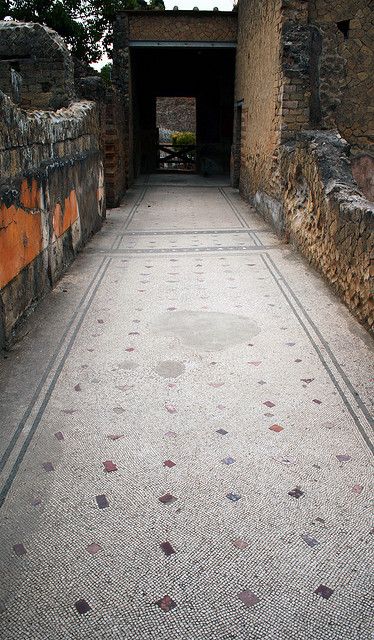
The most impressive building in Herculaneum is named after a deer statue that was found on the property. This house must have had a wealthy owner. It has a primo location and a great view of the harbour. The house is separated into many rooms, with elaborate brickwork, tiled floors, extensive gardens and paintings on the walls. There are many statues (copies) in the garden including an aging, drunk, peeing Hercules.
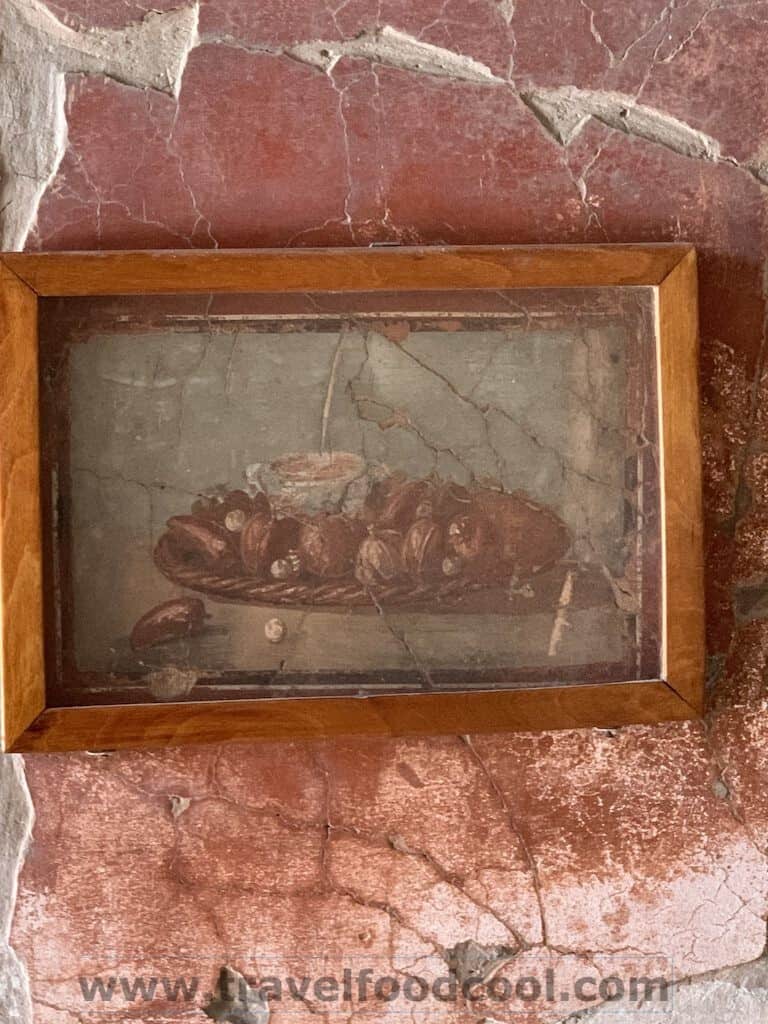
The owner, Q. Granius Verus, was identified by the name on a carbonized loaf of bread. He was a slave who was freed prior to the eruption.
The House of the Mosaic of Neptune and Amphitrite
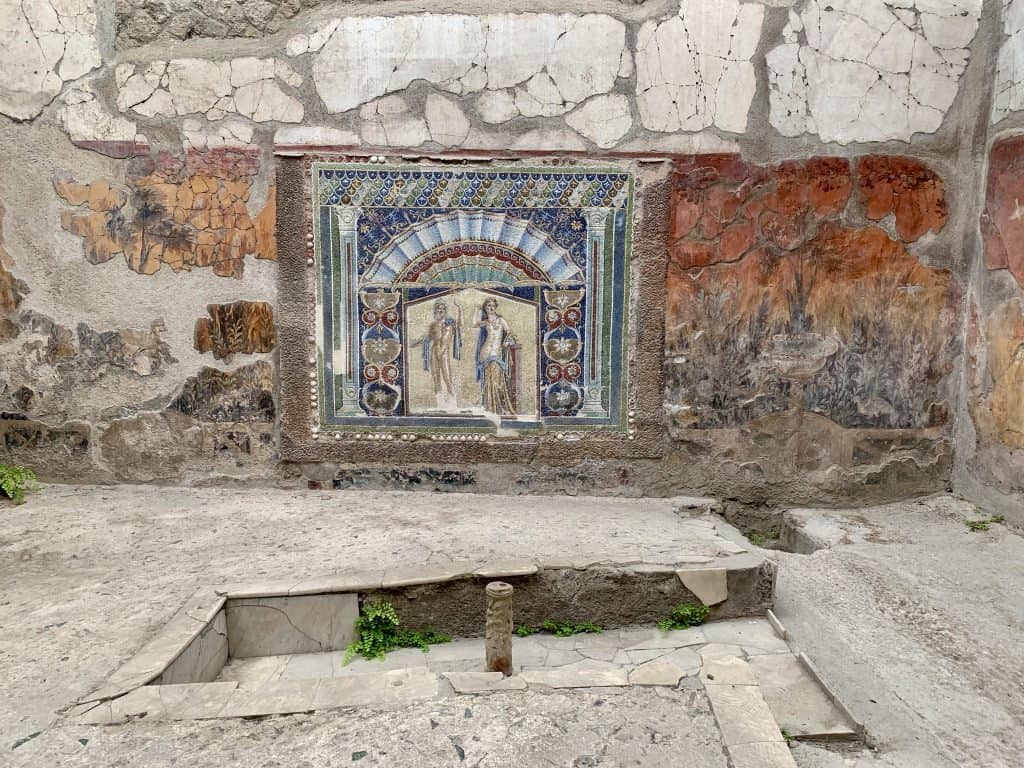
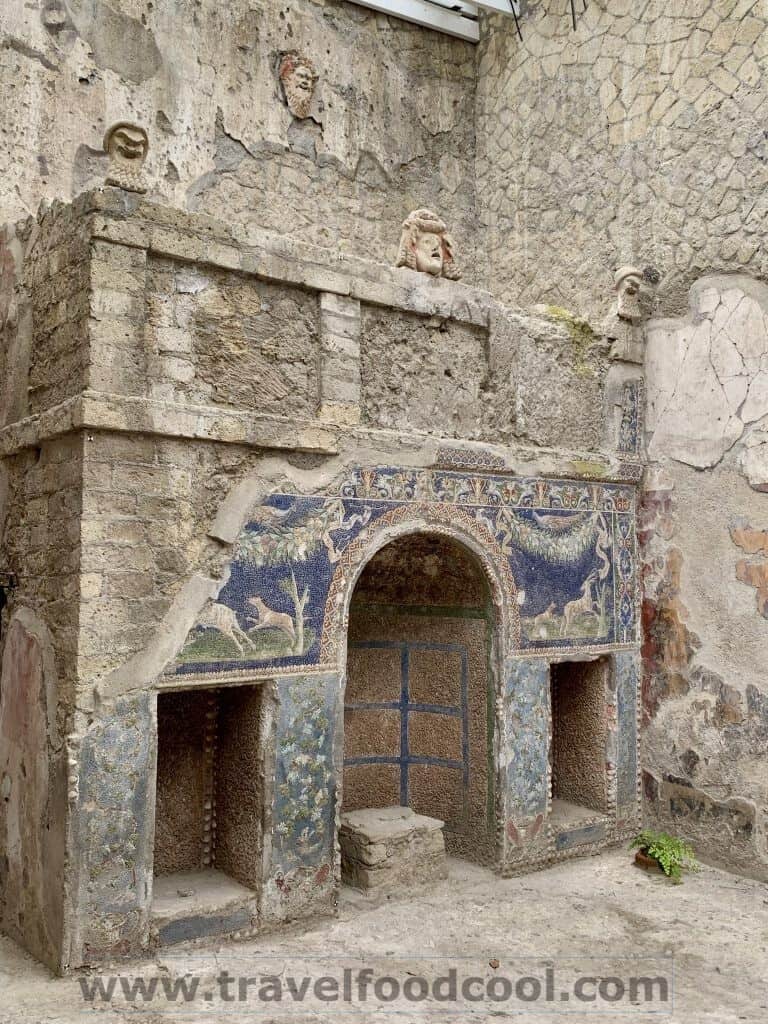
The House of the Mosaic of Neptune and Amphitrite contains some of the city’s best-preserved and colourful mosaics. One theory is that the owner of this house also owned the wine shop next door. This house is clearly that of a wealthy individual. While the house itself is on the smaller side, the backyard is where the owner decided to invest his wealth. The house takes its name from the mosaic of Neptune (with trident in his hand) and his wife, Amphitirite. To the side of the Neptune and Amphitrite mosaic is the nymphaeum. A nymphaeum is a grotto with a natural water supply (or artificial grotto or fountain) which was dedicated to the nymphs. The nymphaeum has side and central niches with floral motifs and hunting scenes with faces of animals and people watching over the grotto.
The Central Baths
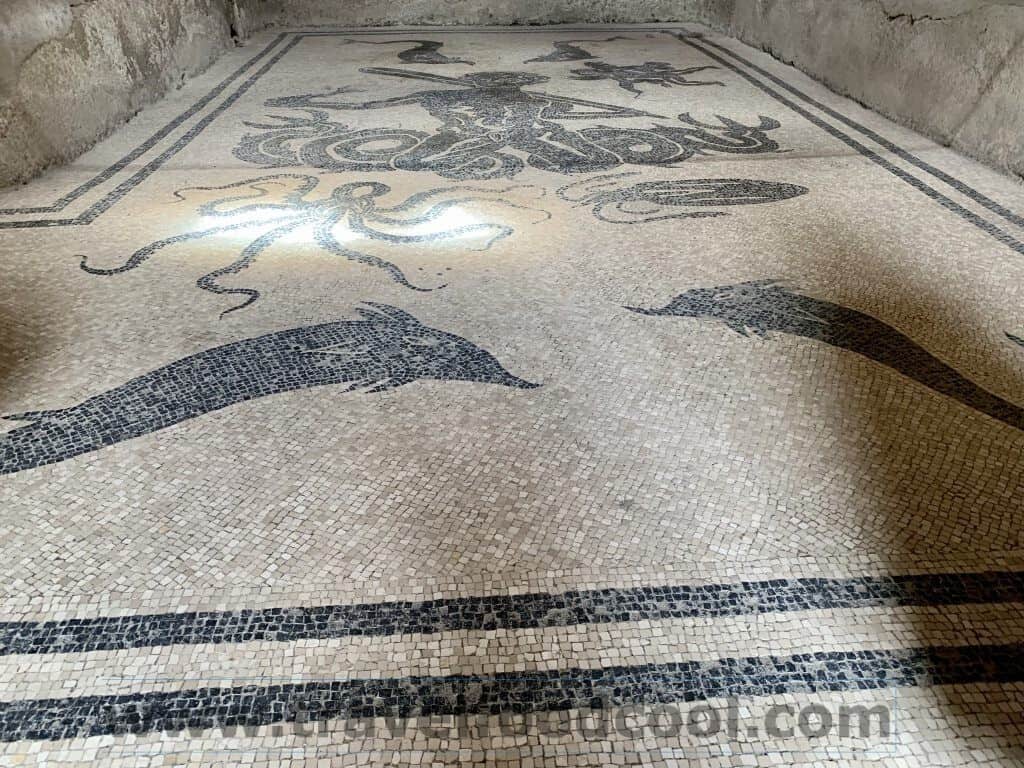
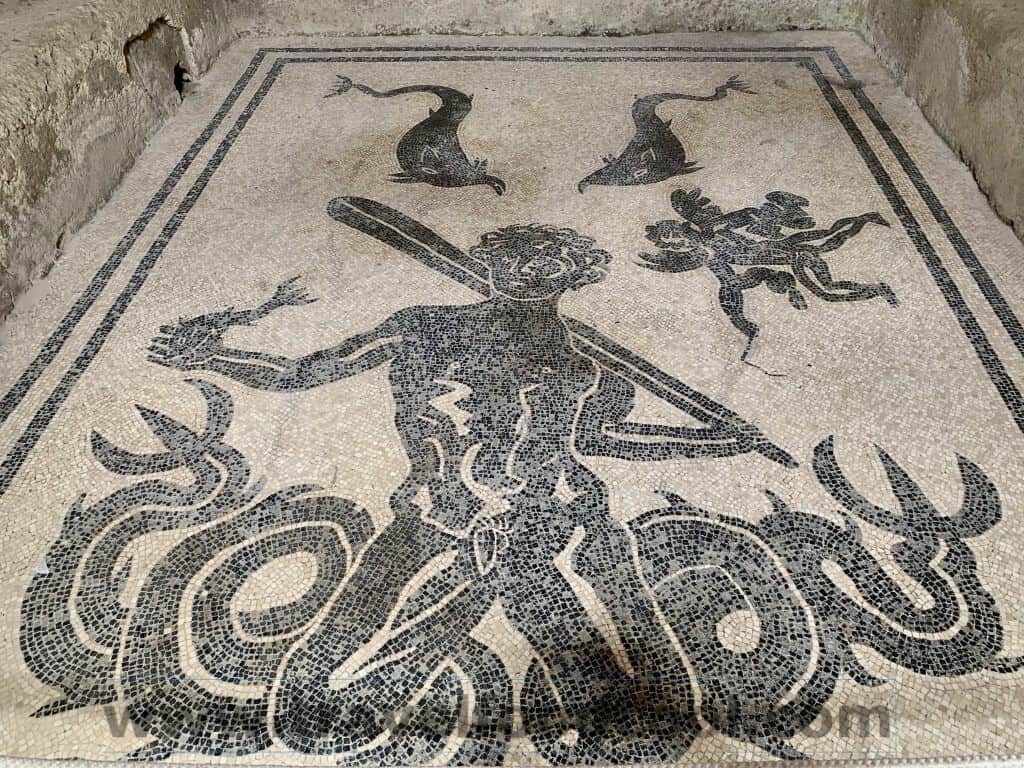
These baths were divided into spaces for men and women. In the changing rooms, you can see niches in which clothing was stored. There was a cold area, a hot area and a temperate area. The floor is a fabulous mosaic, in black and white, of Triton surrounded by a cupid, squids, dolphins and octopi.
The Shopping Markets
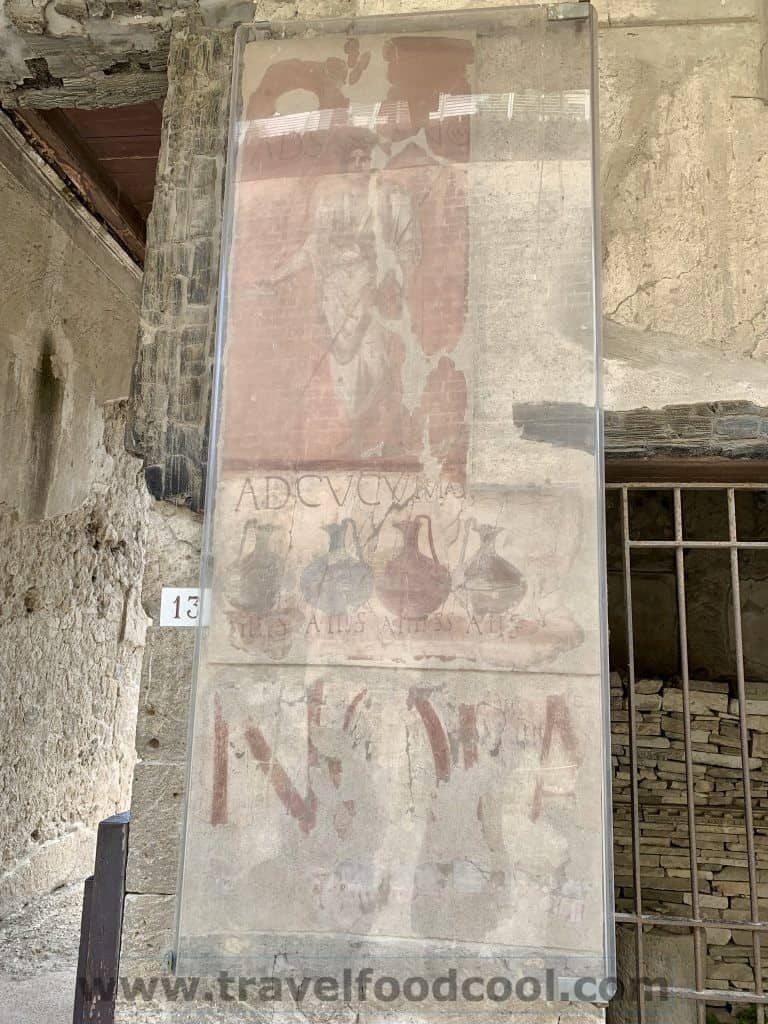
A local store advertising wine for sale. This is also the location of a lot of the Herculaneum shops and stores.
The College of the Augustales (Sede delgi Augustali)
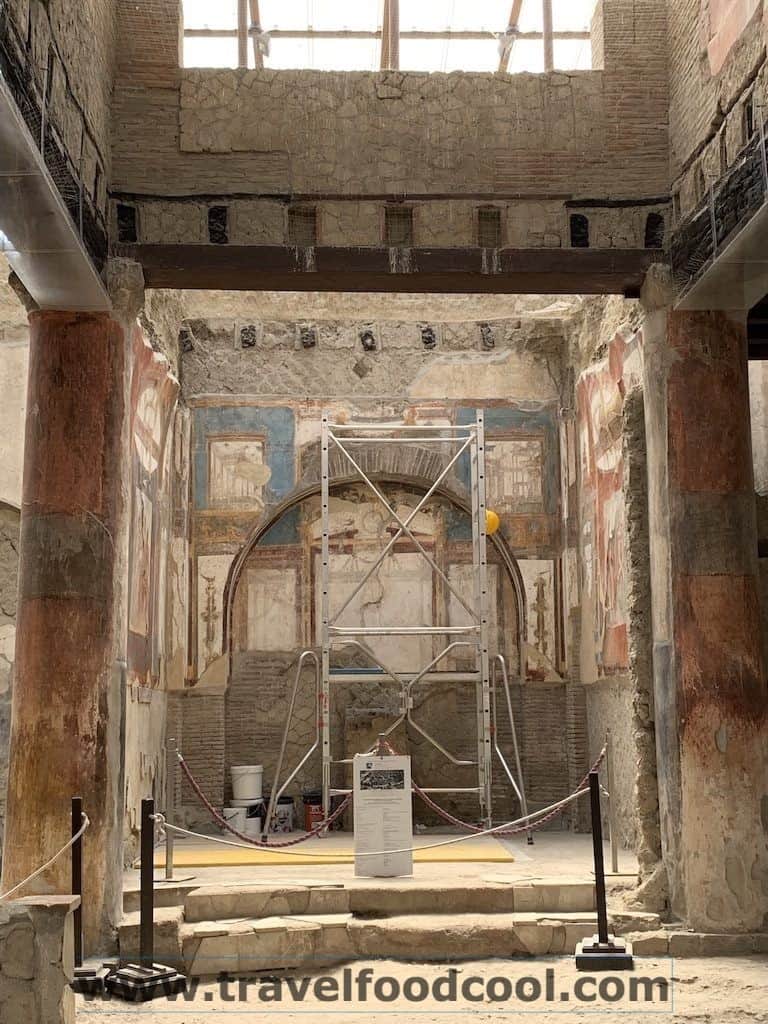
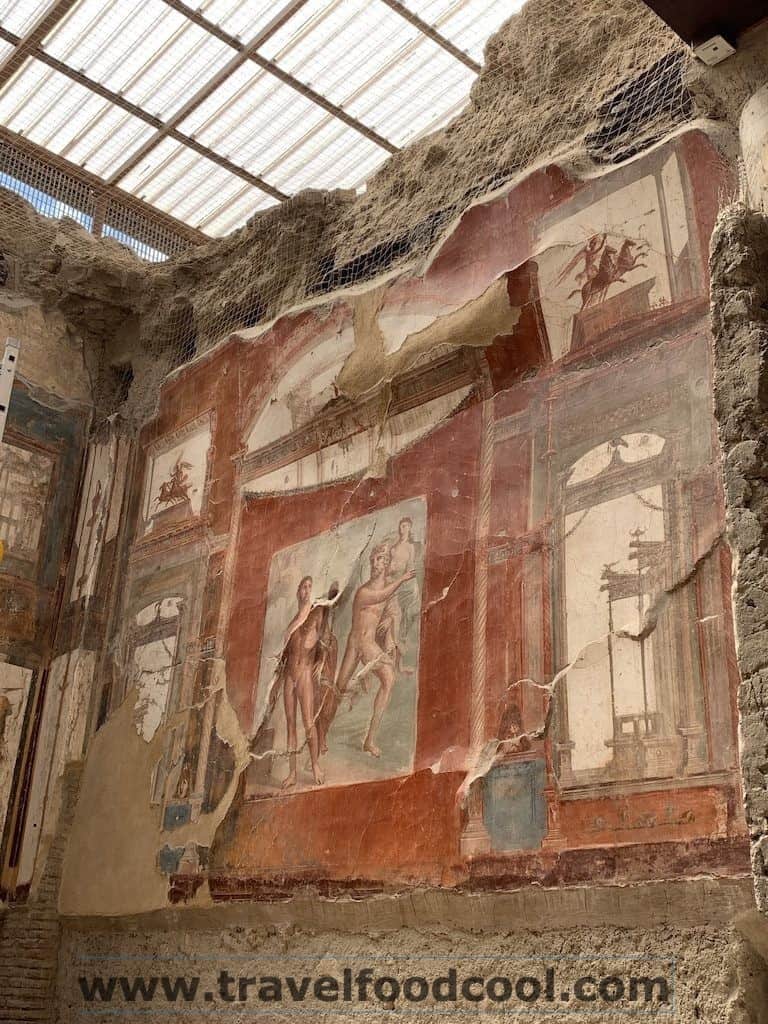
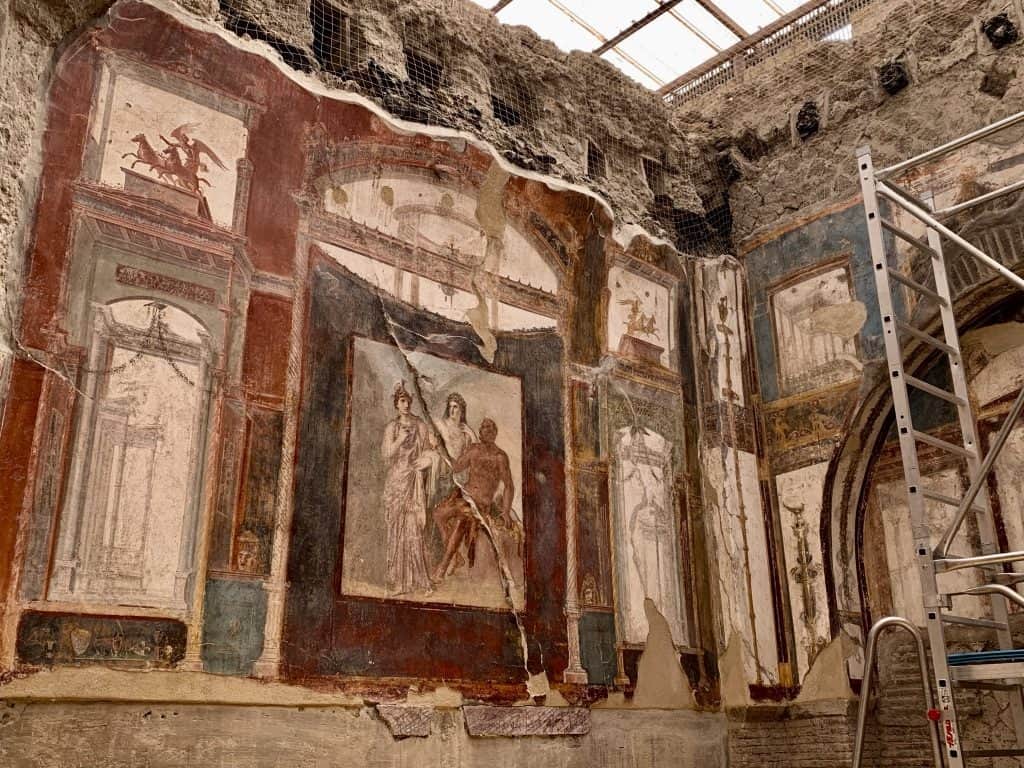
This large frescoed structure was the location of College of the Augustales, the free men who were devotees of the cult of Emperor Augustus. The room is spectacular with many columns and arches. On the left wall, there is a fresco of Hercules entering Mount Olympus accompanied by Jupiter, Juno, and Minerva; the fresco on the right wall depicts Hercules wrestling Achelous. Side note, the building’s caretaker was a Vesuvius victim – his skeleton was found in his room, laid out on the bed.
The House of Wood (Casa del Tramezzo di Legno)
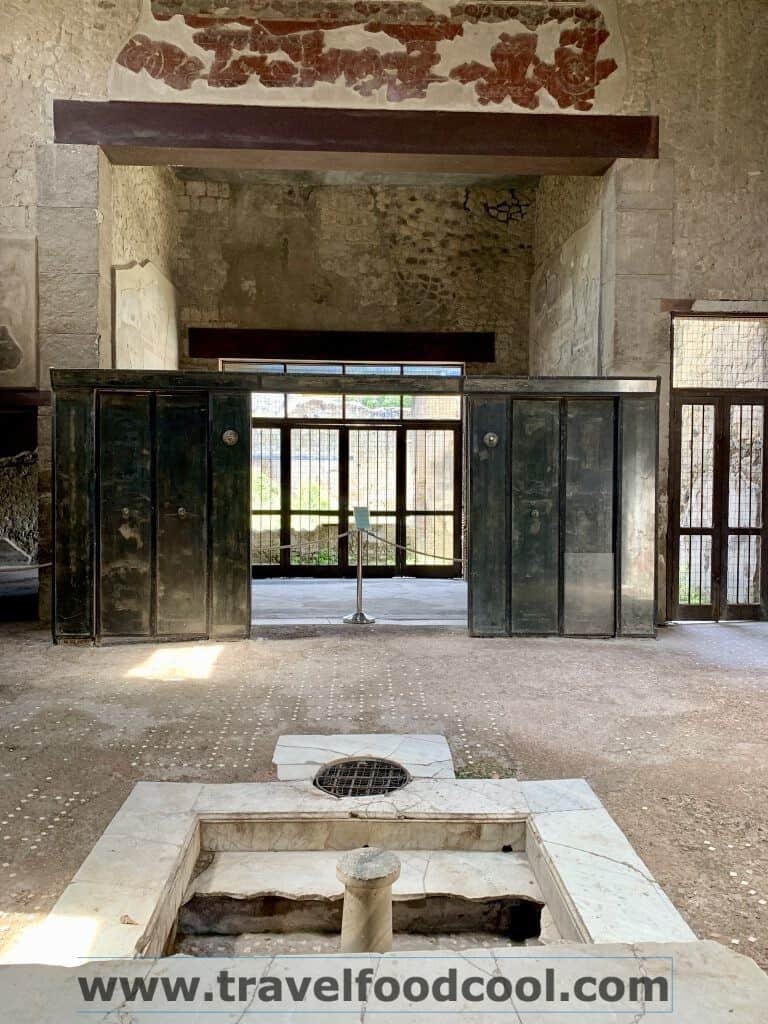
This house is named after the wooden screens (tramezzo di legno) that are standing in their original location and miraculously survived the eruption. A fountain or reflective pond in the centre of the room still shows its tiled floor. The door has a series of folding panels that served to separate the atrium and the main room and create a sense of privacy.
Samnite House (Casa Sannitica)
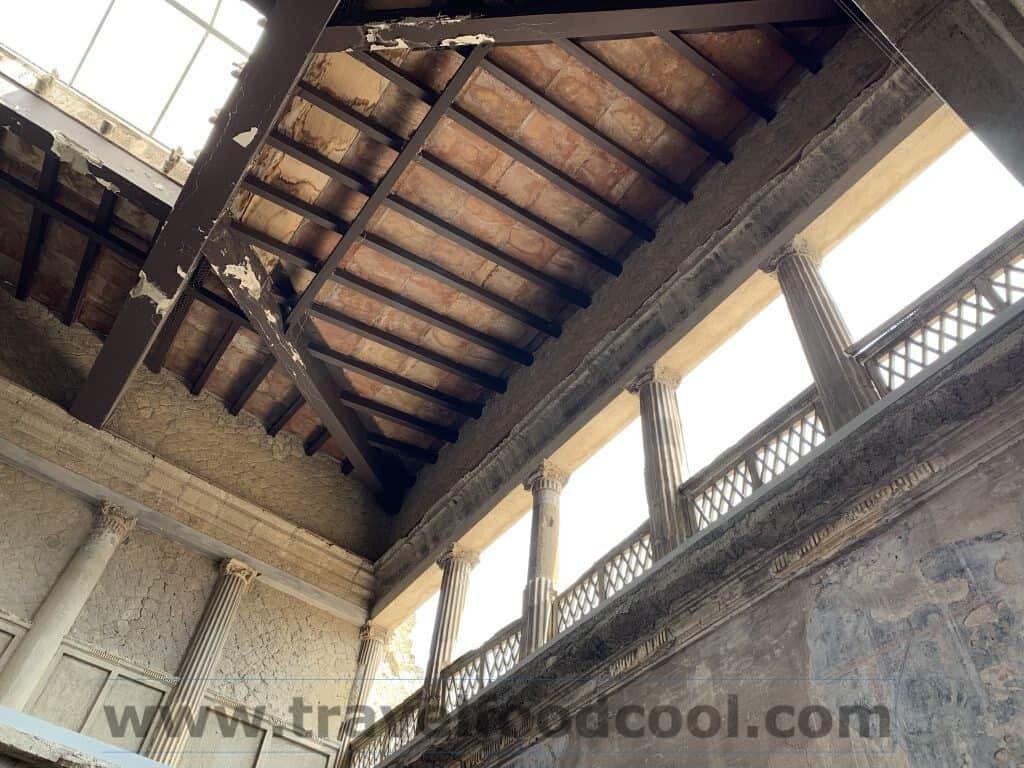
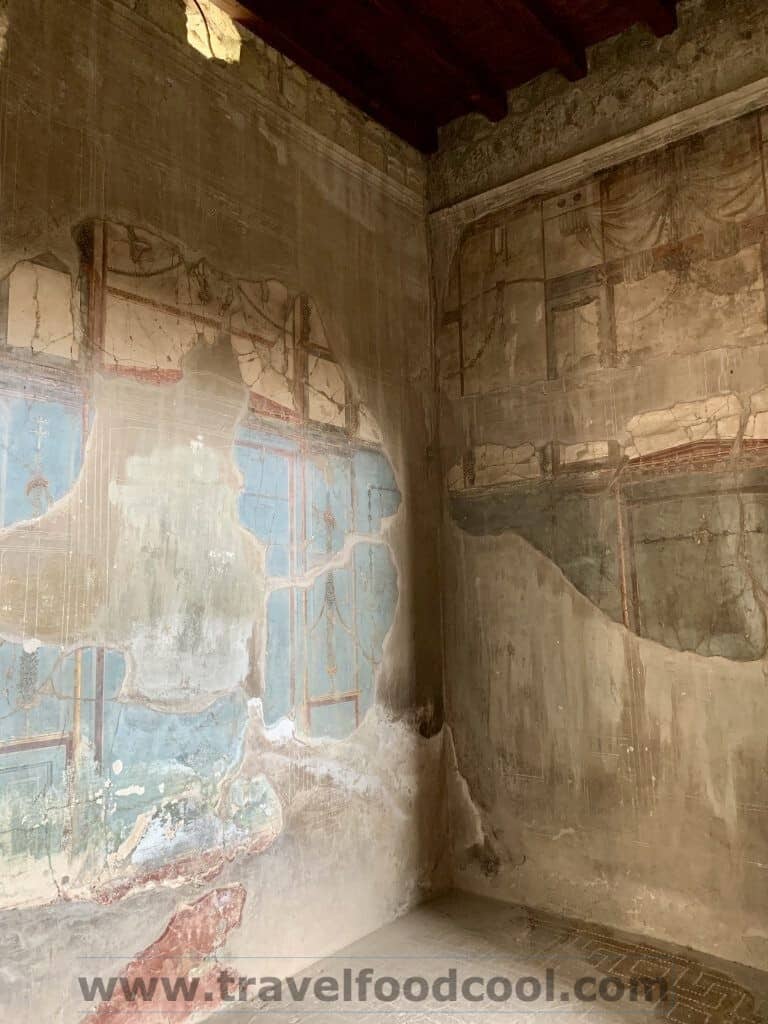
This is one of the oldest houses in Herculaneum, from 2BC. This preserved two-story building with original timbered ceiling is also famous for its faux loggia, mosaic floors, painted walls and the upper floor galley.
House of the Relief of Telephus (Casa del Rilievo di Telefo)
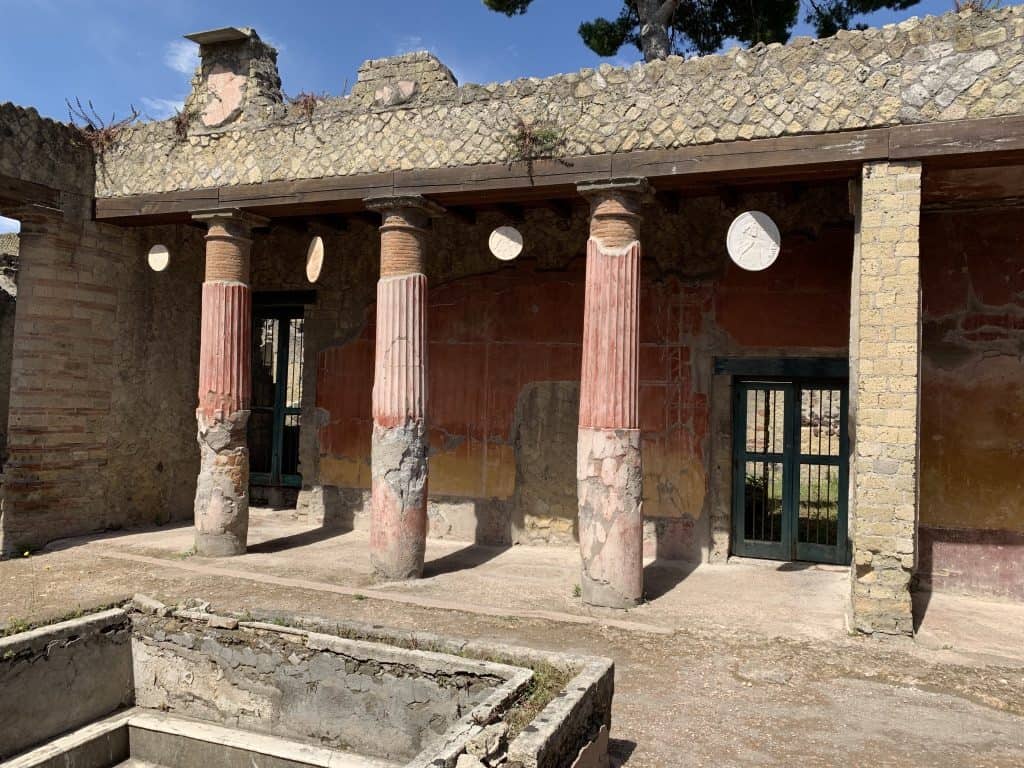
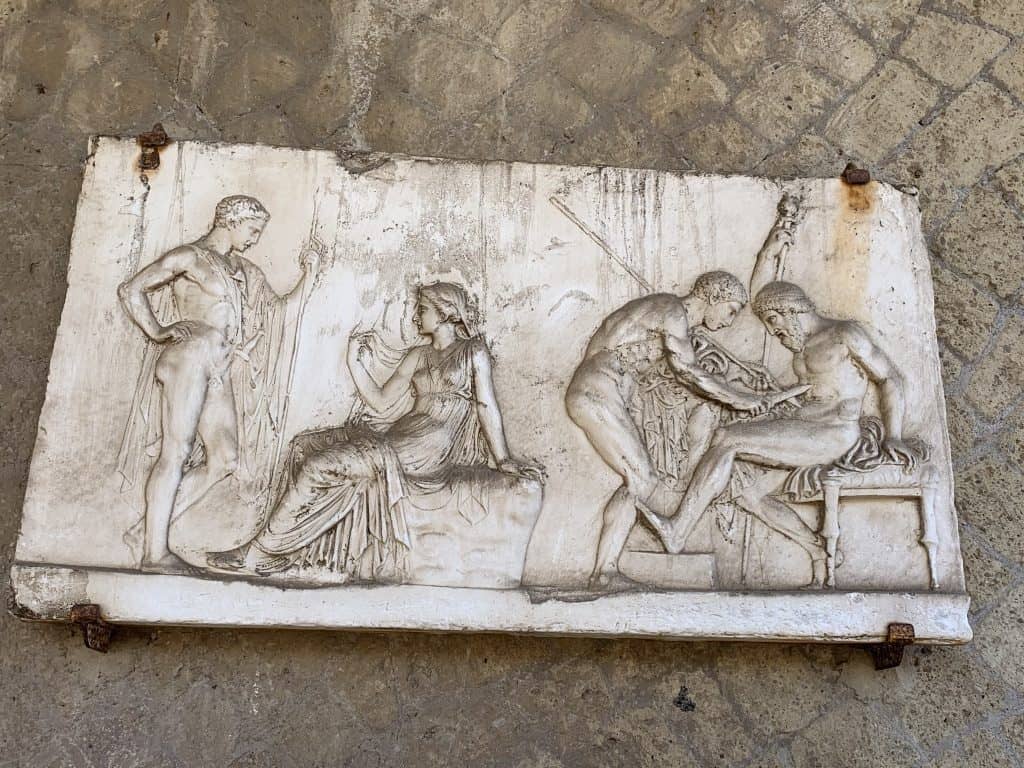
In another example of location, location, location, this house, built between 27 BC – 14 AD, is on a ridge that overlooks the marina. It is a three-story home which is decorated with sculptures, the most famous of which is the relief of Telephus (Rilievo di Telefo), son of Hercules, the founder of the city. The columns which support the upper floor and line the atrium have hanging marble discs, or oscilla, which were used to ward off evil spirits (but clearly not volcanos).
The Terrace of Marcus Nonion Balbo (La Terrazza di Marcus Nonio Balbo)
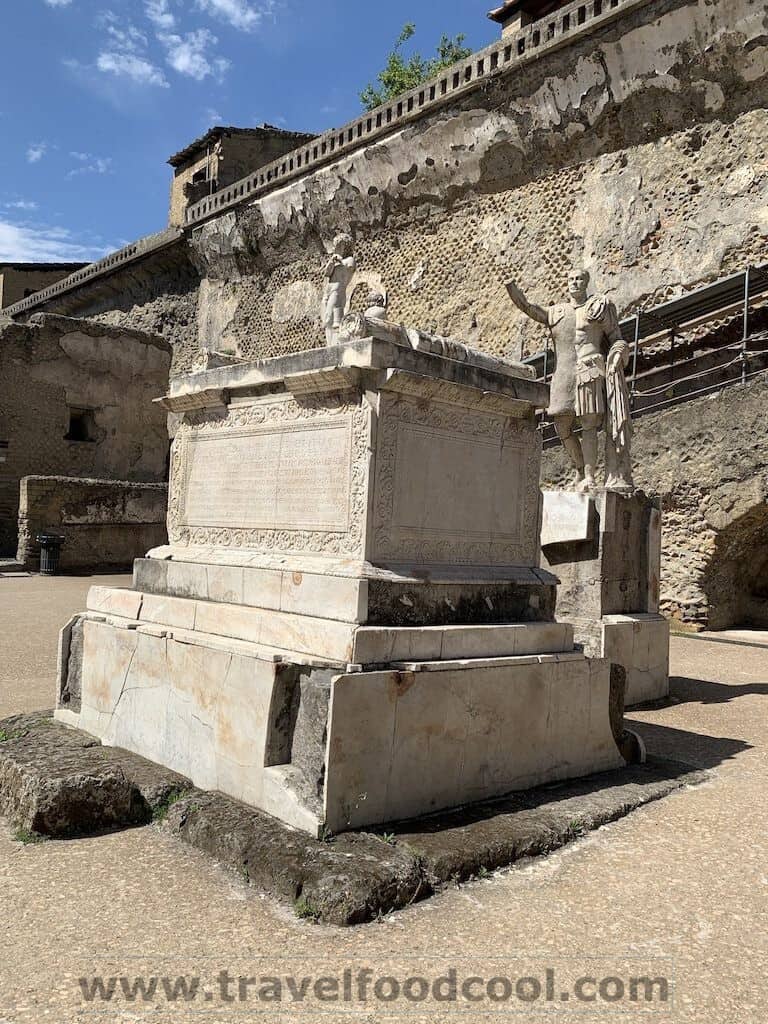
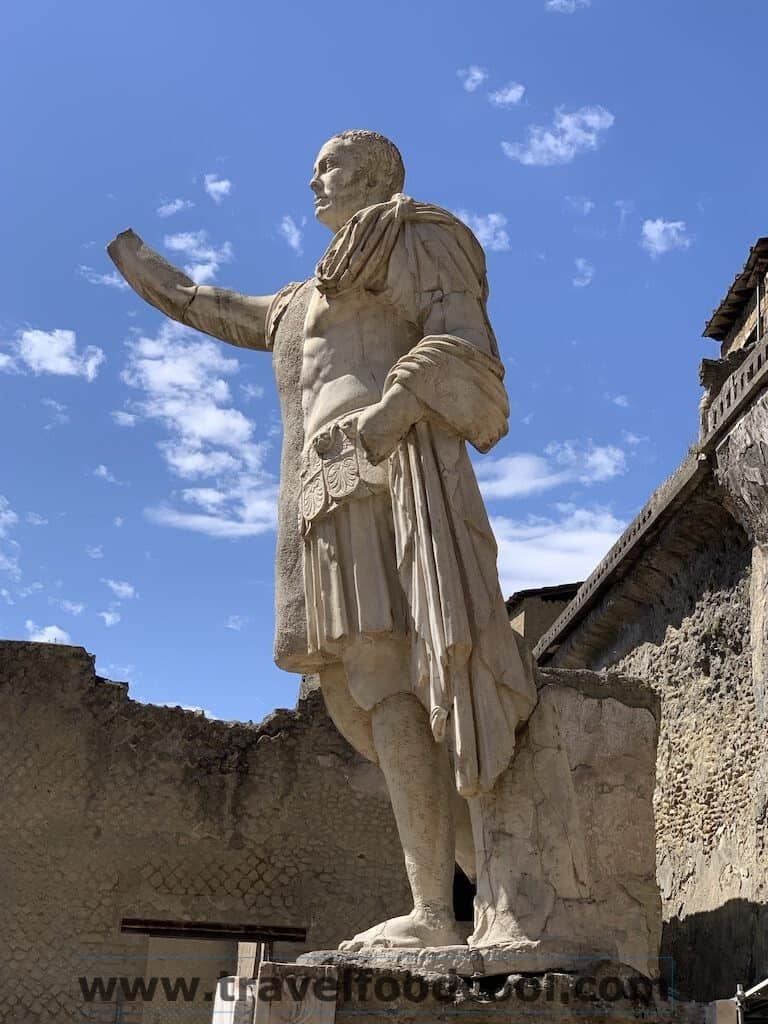
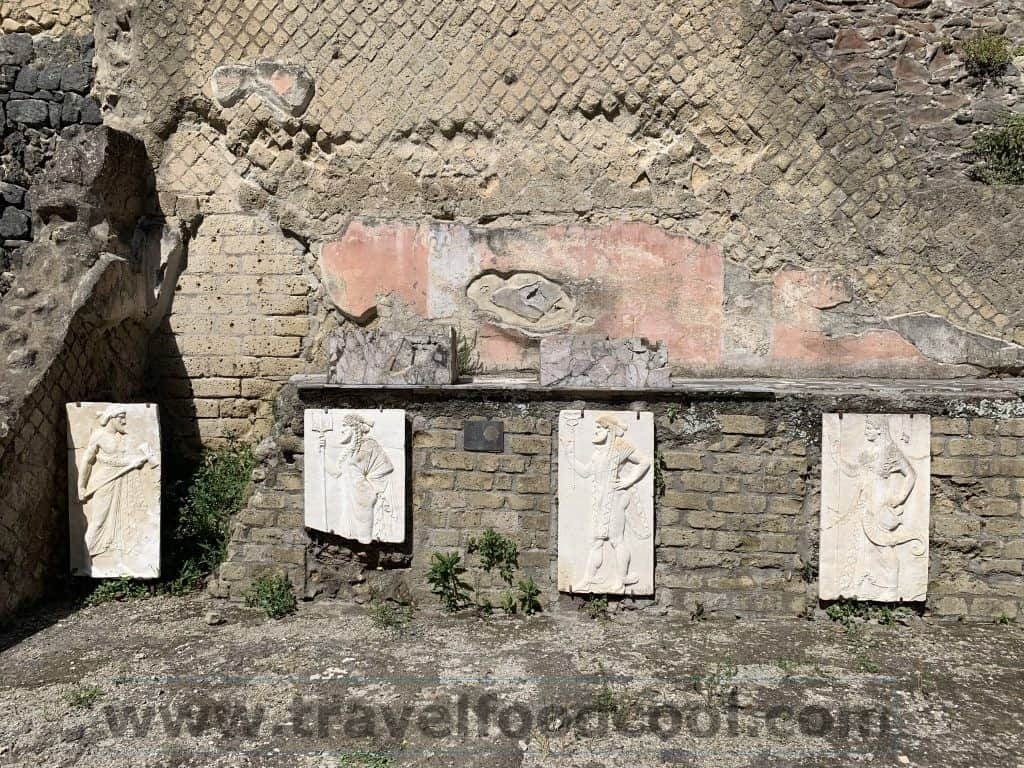
This area was originally close to the beach and boathouses. It’s named after the Marco Nonio Balbo statue found there. Balbo was a Senator and proconsul of Crete and Cyrene who lived in Herculaneum and was a benefactor of the city. He was recognized for promoting Herculaneum’s grandeur and status as a fine living environment, even though he was originally from Nuceria. Upon his death, he was cremated at this location and his ashes stored in the marble base. The head of the statue was crafted separately from the body and was removed during the first wave of the eruption, later to be found by the base of the statue. The body was split in two during the second wave – one half was found by the beach and the second half has not been recovered (it may have been permanently destroyed in the eruption). This is a copy of the original. The marble facade on which he stands outlines his accomplishments.
This terrace is a great viewpoint and photo spot.
The Port Warehouses
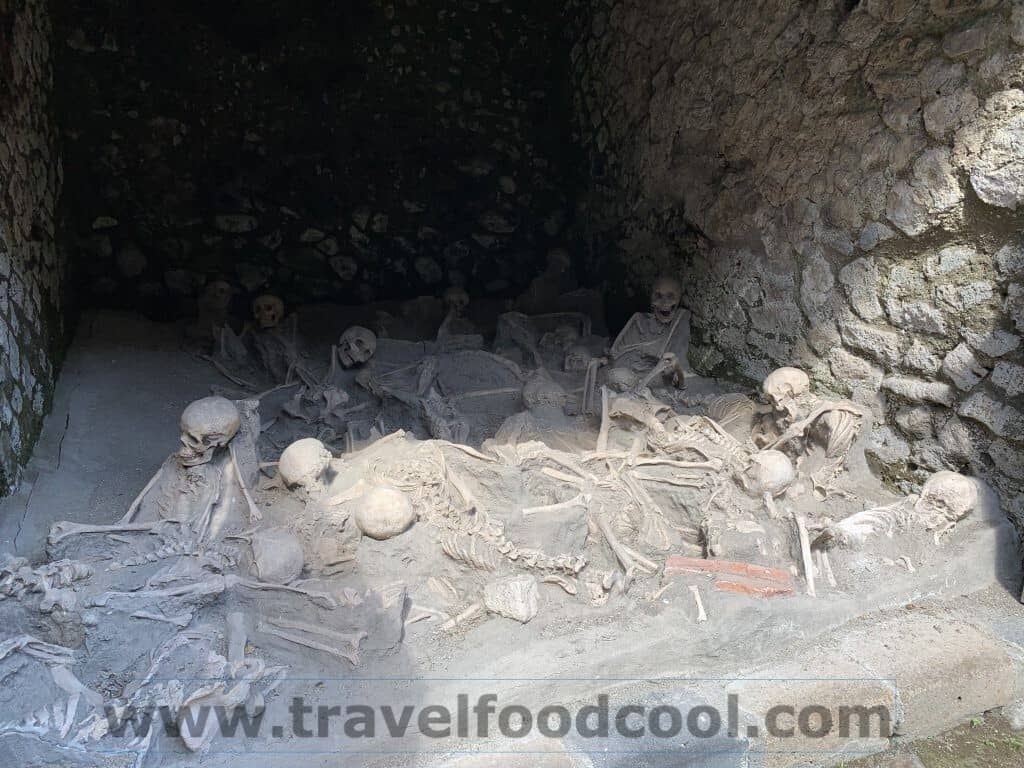
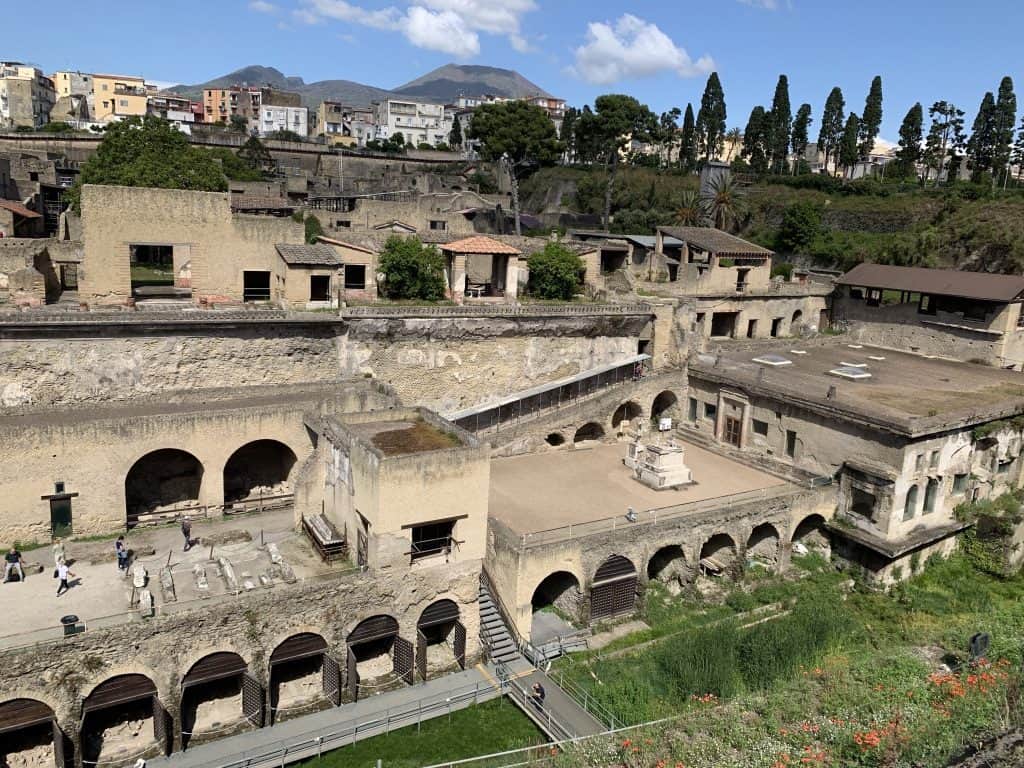
The last spot is perhaps one of the saddest: the port warehouses. This space tragically shows that not everyone escaped the eruptions. The 300+ people who perished here probably came down to the warehouses in order to seek refuge from the toxic smoke and ash or escape by water. These bodies were found with personal objects like jewelry and coins. A Roman ship (nine-metres long!) was also found with skeletons of the rowers as well as a soldier complete with belt, two swords, chisel and coin purse (with coins).
Herculaneum is definitely a fantastic spot to visit, especially if you are not a big fan of crowds. There were times when we were the only people on various roads or inside houses. You can definitely have ample time to yourself at this site.
If you go: take the Circumvesuviana train which runs between Sorrento and Naples. It takes roughly 25 minutes from Naples and 40 minutes from Sorrento. Exit at ERCOLANO SCAVI.
Open daily: 8:30am – 6pm
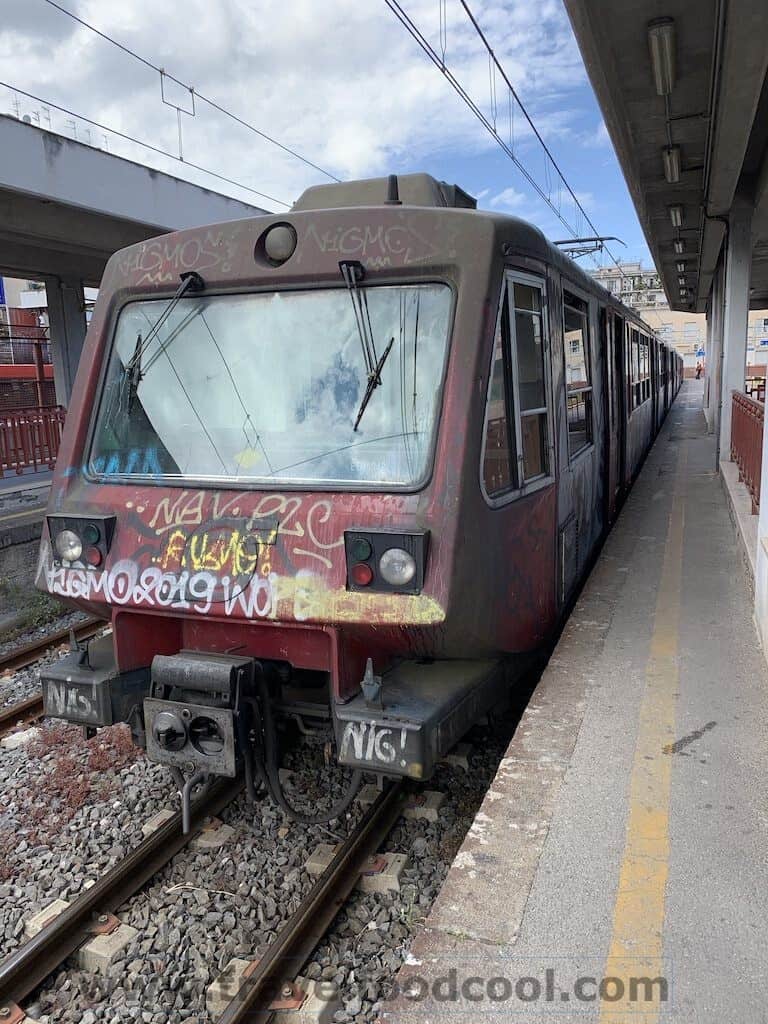
We stayed and would highly recommend the Bellevue Syrene: Piazza della Vittoria, 5, 80067 Sorrento NA, Italy; +39 081 878 1024; www.bellevue.it
Where to eat? Check out our post on Il Buco.
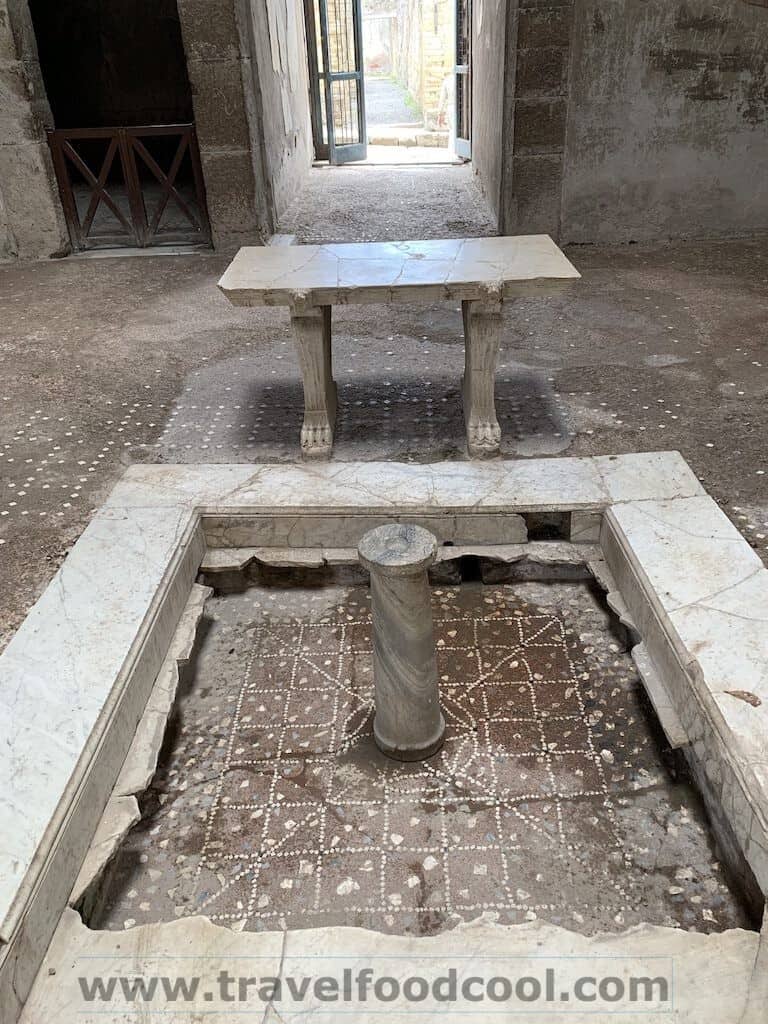






















Very interesting! Love the idea of getting off the beaten path and exploring that time in more depth. Looks like a great place to travel back in time.
Thanks. As you can see from the photos, it much less crowded than Pompeii, giving you the opportunity to see it at your own pace.